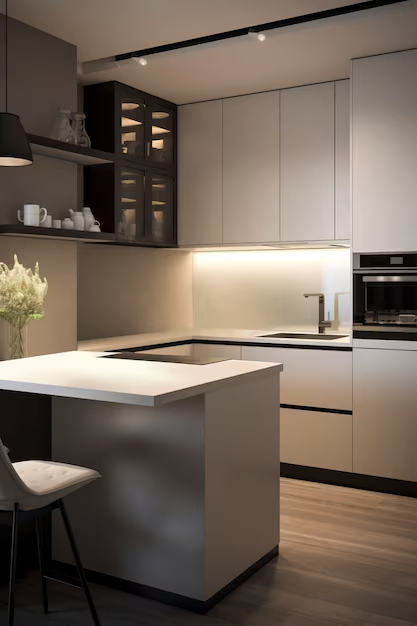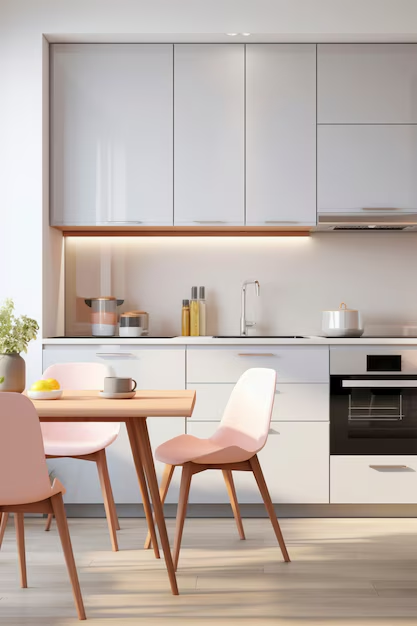The kitchen, often considered the heart of the home, has evolved significantly in terms of both functionality and design. As urban homes shrink, maximizing kitchen space is a top concern for homeowners and designers. One solution that has risen to prominence is kitchen vertical design. This approach uses the kitchen’s height, not just its width. It maximizes every square inch of available area. By shifting the focus to the vertical plane, the kitchen becomes not only more efficient but also more aesthetically pleasing.
The Rise of Vertical Design in Modern Kitchens
In modern urban environments, space is a luxury. City apartments and homes are shrinking. But, the demand for stylish, fully-functional kitchens is strong. Kitchen vertical design is a direct response to this spatial limitation. It lets homeowners build up. They can use all wall and ceiling space for storage, appliances, and decor. By doing so, the kitchen can maintain an open and uncluttered feel while providing more storage and work surface.
This concept isn’t entirely new. In the past, people used vertical space in various ways. For example, older homes had classic floor-to-ceiling cabinets. But, today’s kitchen vertical design uses innovative storage, technology, and sleek design. This evolution solves space issues. It also creates kitchens for modern homeowners. They are tailored to their needs and lifestyles.
The Benefits of Kitchen Vertical Design
- Maximizing Storage Space The main benefit of kitchen vertical design is more storage. By extending cabinetry and shelving upwards, homeowners can use the often-wasted vertical space. Tall cabinets that reach the ceiling can store items used infrequently, such as seasonal cookware and specialty kitchen tools. They keep essential, everyday items within easy reach.
- Creating a Visual Illusion of Spaciousness Vertical elements draw the eyes upwards. This creates a sense of height and openness in even the smallest kitchens. This design tricks the brain. It makes a small room seem larger. It’s useful in small urban kitchens and apartments.
- A key principle of kitchen vertical design is to efficiently organize kitchen essentials. This will improve the kitchen’s function and organization. Using vertical space for storage keeps countertops and work areas clear. This facilitates meal preparation and increases cooking efficiency. Vertical pull-out pantries, for example, are a clever way to store dry goods and canned items while keeping them easily accessible.
- Vertical designs can make a kitchen look more elegant and sophisticated. Sleek, tall cabinetry, for instance, can give the room a polished, high-end feel. Also, vertical design allows for more creativity. You can use statement lighting or art on empty walls.
Key Elements of Kitchen Vertical Design
To successfully implement kitchen vertical design, there are several elements to consider. Each plays a role in crafting an efficient, stylish kitchen while adhering to the principles of verticality.
- Floor-to-Ceiling Cabinets
One of the hallmark features of kitchen vertical design is the use of floor-to-ceiling cabinets. These towering storage units use the full height of the kitchen. They provide unmatched storage space. For smaller kitchens, tall cabinets keep things organized and out of sight. They prevent countertop clutter.
Floor-to-ceiling cabinets look perfect. They eliminate gaps that disrupt the kitchen’s flow. Opting for cabinet doors in matte finishes or soft hues can also enhance the vertical design’s sophisticated appeal.
- Vertical Backsplashes
Traditional backsplashes are usually just between the countertops and cabinets. Extending the backsplash to the ceiling can enhance your kitchen’s vertical lines. This approach not only makes the room look taller but also creates a striking design feature.
A popular option is to use subway tiles installed vertically. Rather than laying them horizontally, orienting the tiles in a vertical pattern draws the eye upward and creates a sense of height. Other materials, like marble or glass, can improve vertical backsplashes. They can add brightness and depth with their reflections.
- Open Shelving
In kitchen design, open shelving is a trendy trend. It allows easy access to everyday items and enhances the kitchen’s vertical flow. The use of tall, narrow shelves keeps the look clean and uncluttered. These shelves can run the length of a wall or be positioned strategically in areas that would otherwise go unused, such as above windows or sinks.
In addition to functionality, open shelving offers opportunities for personalization. Displaying items such as decorative bowls, cookbooks, or greenery can soften the vertical lines and add warmth to the space. Floating shelves, in particular, enhance the illusion of height as they seem to “float” in the vertical space.
- Vertically-Oriented Appliances
Choosing appliances that emphasize verticality also supports kitchen vertical design principles. For example, slim, tall refrigerators or stacked wall ovens make the most of the kitchen’s vertical plane. These appliances often fit perfectly into cabinetry. They create a sleek look that keeps the design intact.
Innovative pull-out pantries and slim storage units use this approach. They save space by using vertical storage. They keep essential kitchen items within easy reach. Vertical appliance designs align function and form. They maintain the area’s coherence and efficiency.
- Vertical Lines and Patterns
Adding vertical lines or patterns in the kitchen enhances its height. Vertical stripes on wallpaper, painted designs, or aligned tiles can make a room seem taller. They draw the eye upward. Combining these with recessed lighting or pendant lights hanging from high ceilings can amplify the effect.
Planning the Layout: How to Do Kitchen Vertical Design Efficiently
A vertical kitchen needs a smart layout. It must combine storage, function, and style. When considering how to do kitchen vertical design, planning is key. Here’s how to approach it:
- Vertical Storage Solutions
In vertical kitchen design, storage is no longer confined to lower cabinets and countertops. Wall-mounted storage, like open shelves, hanging racks, or tall cabinets, uses space better.
- Upper Cabinets: These can reach the ceiling. They provide storage for rarely used items. If you opt for high cabinets, it’s wise to invest in retractable shelving mechanisms that make accessing high-up spaces easier.
- Open Shelving: Open shelves can help prevent a cramped feeling in the kitchen. They make commonly used goods easily accessible. When choosing open shelving, consider the visual impact. Items on display should be organized and aesthetically pleasing.
- Hanging Racks: One popular option in vertical kitchen design is to install hanging racks for pots, pans, and utensils. This not only saves cabinet space but also keeps everyday cooking tools within arm’s reach.
- Utilizing Wall Space
For kitchen vertical design, think beyond traditional cabinets. Use all the available wall space.
- Magnetic Knife Strips: A wall-mounted magnetic strip stores knives. It makes access simple and conserves counter space.
- Pegboards: They are a great option for vertical kitchen design. You can hang kitchen tools, baskets, or small shelves on them. They’re highly customizable and can be rearranged to suit your evolving needs.
- Hooks for Mugs or Utensils: You can add hooks underneath cabinets or along walls for items like mugs, measuring cups, or cooking utensils. This creates easy access to frequently used items while keeping counters clear.
- High Ceilings: A Blessing for Vertical Design
If your kitchen has high ceilings, you have a golden opportunity to capitalize on the vertical dimension. Tall ceilings suit grand cabinetry. It can triple storage without using floor space.
When considering how to do kitchen vertical design in a high-ceilinged kitchen:
- Tall Cabinets: These create a bold statement and add a sense of luxury. Use the top sections for less-used kitchenware. The bottom sections can hold daily essentials.
- Decorative Features: Don’t shy away from decorating high up on the walls. Consider hanging art, adding plants, or displaying unique cookware on floating shelves. This helps draw the eye upwards, accentuating the verticality of the space.
- Ladders or Stools: Installing a stylish ladder or keeping a foldable stool in the kitchen makes it easy to access high shelves. Many modern kitchens use sliding library-style ladders. They add function and a unique look.

The Role of Color in Vertical Design
Color choices are critical in kitchen vertical design as they influence the perception of space and height. Lighter shades, such as soft whites, creams, or pastels, are ideal for reflecting light and creating an airy, expansive feel. However, bold colors, when used in moderation, can enhance vertical elements. They add contrast and visual interest.
For example, paint one wall or a backsplash in a rich color. Keep the rest of the kitchen neutral. This will highlight that vertical feature. Using darker hues for lower cabinets and lighter tones for upper ones can create a layered effect. This reinforces the vertical lines in the space.
Considerations for Small Kitchens
In small kitchens, the principles of kitchen vertical design are even more critical. With limited space, every inch must be used wisely. Vertical storage can greatly improve a kitchen’s look and function.
Multifunctional Furniture and Appliances
Incorporating multifunctional furniture and appliances is key to optimizing a small kitchen. Storage and counter space can be increased with a kitchen island that has built-in cabinets or shelves. A fold-out table or breakfast bar can be tucked away when not in use.
Vertical storage units with built-in appliances, like microwaves and ovens, can help. They free up counter space and create a cohesive look in a small kitchen.
Conclusion
Kitchen vertical design is a new way to rethink kitchens. It’s especially useful in urban areas with limited space. Homeowners can create a stylish, functional kitchen. They can do this by using vertical surfaces for storage, appliances, and decor. This design trend maximizes space and efficiency. It allows for more creativity in layout and aesthetics.
Kitchen vertical design is shaping the future of kitchen interiors. It uses floor-to-ceiling cabinets, open shelving, and new storage solutions. As living spaces evolve, this forward-thinking approach will be key in modern kitchen design.